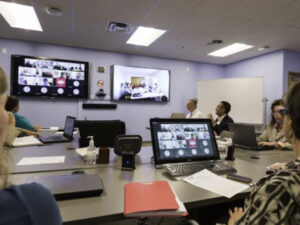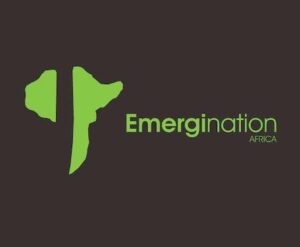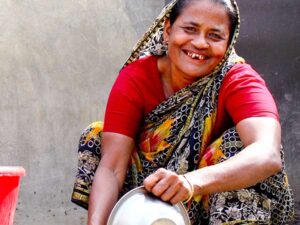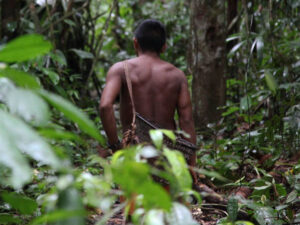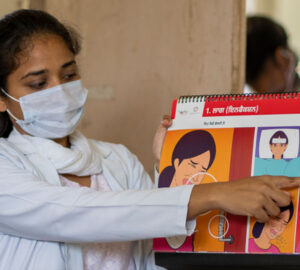Fair Count works to ensure that Historically Undercounted Populations in communities in Georgia and beyond are fairly and accurately counted in the Census. The organization also works to strengthen and increase civic participation in rural and under-resourced communities.
Rebecca DeHart of Fair Count spoke with Ambika Samarthya-Howard on November 2, 2023. Click here to read the full conversation with insights highlighted.
Ambika Samarthya-Howard: Please tell me a little bit about yourself, your organization, and your relationship with the organization.
Rebecca DeHart: I am Rebecca DeHart. I’m the CEO of Fair Count. We founded Fair Count in 2019 in advance of the 2020 decennial census. It was actually founded by Stacey Abrams after her gubernatorial bid in 2018 where she was not successful. Funding the census was one of the main things that she wanted to do if she were to become governor, and she wasn’t able to. She had this idea, “Well, we should just start this organization to do it.” She asked me to come and start Fair Count. March 2019 was our official launch.
Ambika Samarthya-Howard: Can you tell me a little about what the organization does?
Rebecca DeHart: Our overwhelming goal is to achieve a fair and accurate count in the census, particularly of historically under-counted communities. In order to do that, and in order to have longevity, we build a long-term vision of power building and deep community organizing, specifically in Black, Latinx, and Native communities in the Deep South, to build power, civic readiness, civic action, and civic participation in advance of the redistricting that follows each decennial census.
While the census is our North Star, we use all the other iterations of civic engagement as catalysts for the ability to build power, make connections, and build trust in communities that have little to no civic infrastructure.
Ambika Samarthya-Howard: Do you consider yourself a direct service organization? What is your approach? Is it mostly canvassing houses?
Rebecca DeHart: No, I don’t consider us a direct service organization, but I think there are direct service aspects of our organization that are successful. We build our strategies from the community. We have three buckets of organizing. We have community partnerships, faith connections, and technology innovations. Faith connections in rural areas in the Deep South are so important to the fabric of the community.
Technology innovations is our term for digital equity, which we think is, by and large, a racial equity issue. We use those three buckets to build our organizing effort. We have a team of organizers right now in Georgia, and we’ve expanded into Mississippi, where folks work 365 days a year, organizing and building power for particular efforts. In election years, we do a lot of door knocking, phone calling, and texting.
We do everything that a very modern, sophisticated political campaign does. A lot of us come from the political realm, so we run like a 501(c)(3) nonpartisan civic mobilization, or like a pretty hardcore campaign. We use all the tools, we do all the data analysis. We try to be pretty cutting edge in that.
I’d say our center of gravity, our heart, is with our organizers. They have to do three to five one-on-ones every week with members of the community, through which we learn a robust amount of information, not just about civic engagement. Do you have a grocery store? Is there a pediatrician? Are you one of the 69 counties without an OBGYN? What do people do for fun? Where’s the main employer?
The conversation lasts about an hour, and my favorite question comes at the end: If we want to understand your community, who are the three people we should talk to? We talk to the county commissioners and the folks that you might generally think you would organize, but we also talk to the guy who’s running the dominoes game out of his garage, and we talk to the church volunteer secretary who’s been there for 60 years and knows every single person.
From them we learn the pulse of the community, and we build programs that are very specific to that area to engage people where they are. I’m a social worker by trade, so I have a strong belief in the whole theory of person and environment. If you’re to really reach someone, you have to understand who and where they are, and where they come from.
Ambika Samarthya-Howard: How does that relate to the census work?
Rebecca DeHart: We see the census, like so much else, as dealing with structural racism. White supremacy has built a system that ensures some people are not counted, are not heard, are not seen, and that certain people don’t get the resources they need, and don’t get the political representation they deserve. Year after year, decade after decade, we see that white people are over-counted in the census, while communities of color are under-counted, and small children are under-counted.
What’s interesting is that the data shows that communities of color with really high vote share gaps are often the same communities that are under-counted by the census. We see this diving board, if you will, at the beginning of every decade, where it’s like you’re jumping off for the next 10-year trajectory. If you are severely under-counted, you’re going to be jumping off with fewer resources, with less political representation, and you are more likely to be targeted by some of these fringy voter suppression laws, that aren’t so fringy anymore. The communities that we work with are often bearing the brunt of the problems that come with highly partisan, highly gerrymandered politics. Every decade we see this as an opportunity to try and achieve more equity in the system and in the census, specifically.
Ambika Samarthya-Howard: How does that relate to the one-on-one conversations and the need assessments?
Rebecca DeHart: I think there are a lot of reasons why people are under-counted in the census. One, the system was built to count homeowners who live in suburban communities, and it doesn’t take into account the myriad of ways that people live in America. More than that, there’s a feeling of distrust with the government. “Why would I tell people my business? Is this going to get me in trouble for other reasons?”
This past census was totally politicized when the former president tried to get the Department of Justice to say that we should not be counting undocumented persons. His administration conflated the idea of data collection with fears of the ICE knocking on your door for deportation.
There’s a lot of fear that goes into this counting, a lot of mistrust, a lot of, “Why should I participate in a government that never served me?” It takes a lot of trust-building, education, and civic engagement to build civic participation.
Ambika Samarthya-Howard: Do the one-on-one conversations fill that gap?
Rebecca DeHart: One-on-one conversations definitely fill that gap, and many of the programs that we build are based on those one-on-one conversations. We’ll have all the metrics that a campaign might have, and then on top of that, we’ve done I don’t know how many thousands of one-on-one conversations since we started. Then we’ll be in those communities filling those gaps, and creating programs that hopefully speak to the needs articulated during those one-on-ones. When the pandemic hit, we never thought we would be ensuring there were vaccines in rural areas.
That’s exactly what we had to do because our governor was actually closing vaccine centers in southwest Georgia, where Black communities were dying at a higher rate than they were in the origination spot in China and in New York. He just shut them down because not enough people were utilizing them. We came to find out that the reason why people weren’t utilizing them is because they were only allowing vaccines for people aged 65 and older.
The health disparities are so bad in that area that the average life expectancy for an African American doesn’t even hit 65. Then they had to have a QR code on their phone to be able to drive through and get the shot. We turned into a vaccine [service], and that’s why direct service every once in a while will be a part of what we do. This is why civic engagement and being counted and all this matter so much.
We started partnering with vaccine providers, and I think we gave 7,000 shots to people in rural areas that year. When we were actually doing GOTC [get out the count] work, that was one of my favorite things because in Georgia, there are like, 50 counties that don’t have a pediatrician. I don’t know the exact number. We worked with a pediatrician in Atlanta who has a roving van, and we were bringing people in, saying come get your kids a free check from a pediatrician, come get counted for the census, and we have a laptop available so you can complete your census right here.
Ambika Samarthya-Howard: That’s awesome. How do you measure the success of that work? Obviously, by more representation in the census, but I’m also curious about how you find evidence of the impact of the work you’re doing.
Rebecca DeHart: I would say we measure success in two ways. One way is the way a lot of campaigns do it, by measuring our own outputs. We know the industry best practice standards, and we measure how many metrics we meet, as far as voter contact, for example. We like to go a little bit further and measure ourselves against the output of the effort, which can be a little scarier, especially right now, when sometimes things don’t go as we planned. There was a nationwide plunge in Black voter turnout in the last midterm elections.
I think it’s important for us, too, because we’re also taking the long view. What that looks like for the census specifically, and then voting, is pretty interesting too. In the census, we judge ourselves by the self-response rate. The gold standard of census data is people who participate on their own, and don’t have to have the non-response follow-up units go to their door to try and gather information, or talk to neighbors [to get information].
The census self-response rate was actually the best in Georgia, which was great because the last time we did it in 2010, we had a president who was really encouraging the communities that we work in to participate in the census. We were pretty proud that we did a smidgen better than we did [in 2010], especially with the pandemic. For voting, we look at vote share gaps, which is fun. It gets really into the data.
We have this great visualization where you can click on any county in the 12 southern states, and find out the Black vote share gap or Latinx vote share gap in various elections. If 30% of the county’s registered voters are Black, then you would expect that 30% of all votes cast for an election would be coming from Black voters.
Instead, we see gaps, and numbers like 25% or 26%. We get this over-saturation of White voices in our elections in the Deep South by design, in a lot of different ways. We believe if we can achieve equity in our elections, state, federal, and local, then we’ll have a much more equitable electorate participation.
Ambika Samarthya-Howard: What are some things that you’ve done that haven’t worked, that you think would be useful for other people to know about? Maybe not so specific to just the census, or just one aspect of this, but something that taught you a lesson.
Rebecca DeHart: That’s such a good question. I think we’re still mid-lesson, and we’re still figuring out a lot of things, so it’s hard to think of something that we came to a conclusion that didn’t work. We believe in trumpeting what doesn’t work because we learn a lot from that. I think one of the biggest issues that we’re still dealing with is moving out of the virtual space and getting back to in-person organizing.
I think we waited too long. We were an organization that was very safe for our employees, and we didn’t bring people back. I think that was a mistake because a lot of the communities we work in don’t have access to digital equity, either. I think being a little more bold and a little less coddled, for lack of a better word, because I think we maybe coddled the situation for a minute, would’ve been better.
Ambika Samarthya-Howard: What’s a challenge that you faced that you haven’t been able to overcome yet? Is there a limitation in your program?
Rebecca DeHart: There definitely is. We’ve not expanded into all the states that we want to be in yet. That’s a big one. We’re in Mississippi now. In order to really have an impact, we need to get into some of these other states by 2030 because it takes time to build [numbers].
Last year, we hit the metrics, we did all the outputs, we did everything we said we were going to do for VOTE-365, and our turnout was still down in some places. Some of it was a success. We had some counties that vested their Black vote share cap, but in other places, it fell on an average of 1.3%. That was really disheartening.
Something we haven’t taken into account because we haven’t figured out the right way for data analysis [is the impact of suppressed White votes on Black vote metrics]. The Senate race in Georgia is a great example of that because we had Reverend Warnock on one side and Herschel Walker on the other side. We had two Black candidates, but we saw very different behaviors of the White electorate. When we saw increases in Black voter turnout, was it really because we were doing our work, or was it because the White voters suppressed themselves because they didn’t want to support a particular candidate?
Our way of measuring that is difficult to pull off without going into partisanship lanes, and without opening up this whole Pandora’s box of what White people think and do, which doesn’t really help us.
Ambika Samarthya-Howard: Are you saying that you couldn’t figure out how many Black people voted?
Rebecca DeHart: We could, but I’m worried that it was a little bit artificially inflated because White people didn’t vote. We can see turnout numbers, but we look at percentages and the gap, so when we had a lot of White people that did not come out for the runoff because there was Herschel Walker, who might’ve been their preferred candidate generally, it might have shown that we had less of a Black vote share gap than we actually did. It taught us an important lesson about how we start to look at civic engagement events over time, and how we almost weigh them, so we come up with an idea of progress that moves [forward], but we know there are going to be ebbs and flows by variances and factors that we might not be able to account for.
Ambika Samarthya-Howard: Can you just track the Black vote?
Rebecca DeHart: We can, in terms of turnout, but we generally look at the gap over time, so it gets harder to do that because of how transient people are in general. The voter file will change by hundreds of thousands. We think that that’s the most statistically accurate way to do it, but it takes a lot of cycles to get there.
Ambika Samarthya-Howard: Would you say that you’re doing systems-level work, and what does that mean to you?
Rebecca DeHart: Yes, absolutely. I think when we started, one of the cool things was there weren’t a lot of organizations–actually, I don’t know of any other one–that were solely focused on the census. There were a lot of nonprofits that had census portfolios, and that was great, but they were part of larger organizations. We got thrust into the national conversation much more quickly.
Not only are we doing the organizing, but our president has been appointed by the Census Bureau onto the map with the other places. We’re really trying to let other perspectives, particularly those of communities of color in the Deep South, influence our work and to bring those perspectives into the larger systems change by participating in what are sometimes the most delightful and boring statistical meetings that have ever existed. This ensures that they’re not glossed over.
Ambika Samarthya-Howard: You talk a lot about the communities, but who are the other people you’re working with within the system? What are their roles, or what do you need from them?
Rebecca DeHart: Our partners are super important to us. Our faith community, for example, is so important to the fabric of the Deep South. I always shout out the AME Church. There are 540 AME churches in Georgia. That’s a system that we can tap into. We also look at power that exists in different places, like within other organizations that do civic engagement work on the ground. We are stronger together. Georgia’s a big state.
For a while, there was a feeling of scarcity, and people were kind of competitive and turfy. Now we’re saying, “Bring all the resources you can to the state.” That’s a natural trajectory for states. We sit in the New Georgia Project’s peanut gallery. We go to all the board of election meetings, and together, we try to cover 159 counties every month. We participate in other systems of voter protection, which are really important for our community.
We also look at the state systems. They’re not as strong in the Deep South. In states like New York, where we are now, we’re investing 80, 100, 120 million dollars of state funds into boosting census turnout. Most states in the Deep South invest zero in resources and do absolutely nothing. Five out of the six states in the nation that have the largest Black populations are in the South. A lot of the systems just are not doing anything for people or for the effort.
Ambika Samarthya-Howard: How do you see your work evolving over the next five or ten years?
Rebecca DeHart: Our plan is a seven-year plan because that’ll be the culmination of redistricting after our next decennial census. We’re still putting all that together and are about to go through another strategic plan. Ideally, we’re going to expand into all the Deep South states and be working on the ground, augmenting other civic engagement efforts, and really focusing on building power in rural communities and mitigating some of these under-counts by 2030.
Ambika Samarthya-Howard: Are there any insights that you haven’t mentioned from your work, or from your role in your organization that you would like to share?
Rebecca DeHart: I think there are two things that we do well and really believe in, and that we’re proselytizing about all the time. One is to make sure that we’re working in areas that don’t get all the resources all the time. You go to a state like Georgia, which has recently become very well-resourced in political-wide ways, but the bulk of it goes to Atlanta. They’re really large states.
Same thing in Mississippi. We don’t work in Jackson. There are a lot of organizations that are in Jackson, but we’re in the Delta. We’re in South Mississippi. I think in order to have real comprehensive change, we can’t forget the [rural and under-resourced] communities that have been forgotten for so long, and we have to make sure that we’re investing in them. Then number two is we hire from those communities.
I worked in politics for 20 years, and what we did is hire a bunch of kids out of Atlanta, shoot them down to all sorts of places in rural areas, and tell them to organize people. That is not an effective way to foster democracy and make change. We go into the communities where we’re working. We hire people in those communities. Our organizers range from 23 years old to 73 years old. They know the communities inside and out.
They have instant trust. The added benefit is we have this new class of national, best practice-trained organizers in states that are really hard to reach, who can move mountains.
Ambika Samarthya-Howard: That was great. Thank you for talking with me today.
Click here to read the full conversation with insights highlighted.
Ambika Samarthya-Howard (she/her) is SJN’s Chief Innovation Officer: She leads on innovation and technology, leverages communication platforms for the network strategy and creates cool content. She has an MFA from Columbia’s Film School and has been creating, teaching and writing at the intersection of storytelling and social good for two decades. She has produced content for Current TV, UNICEF, Havas, Praekelt.org, UNICEF, UNFPA, Save the Children, FCDO, Global Integrity and Prism.
* This interview has been edited and condensed.
Learn about other organizations working to increase civic participation.


